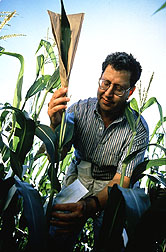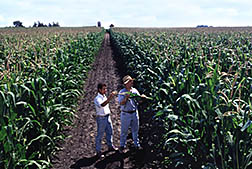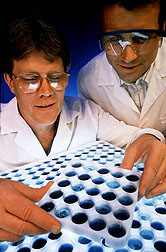Mutant Corn Has Low Phytic Acid
Without enough phosphorus, people and animals grow too slowly and their bones break easily. But this same essential nutrient can turn a pristine lake into an algae-covered grave for fish.
The problem starts when erosion transports soil containing phosphorus from agricultural fields into lakes and streams. Algae thrive on the phosphorus in this runoff. In their exponential growth and decomposition, algae can use up the oxygen in the water so there's not enough for fish or other aquatic wildlife.
A significant source of phosphorus is manure waste from commercial livestock, poultry, and fish farms. Producers apply the waste to croplands as fertilizer.
In the United States, hogs and poultry alone excrete enough waste each year to fill a train of railroad boxcars that would circle the Earth, according to estimates by University of Kentucky animal scientist Gary Cromwell. These 30 million tons of manure contain 460,000 tons of phosphorus. It would take 150 million of the 50-pound bags of 12-12-12 fertilizer you might use in your garden to supply that amount of phosphorus. Cromwell, based in Lexington, is an expert on nutrient use by livestock.
One way to reduce phosphorus runoff is to give farm animals just the amount of the mineral that they need to grow, so they won't pass the excess in their waste.
But nature has made achieving this balance nearly impossible.
The mainstays of agricultural feed—corn and soybeans—contain plenty of phosphorus. But many animals can use only about 15 percent of it. That's because the plants bind up the mineral in a compound known as phytic acid.
Cows, sheep, and other ruminants—grazing animals with more than one stomach--have enzymes that break down phytic acid into a usable form. But in animals with one stomach—hogs, poultry, fish, and even people—phytic acid passes through the digestive tract unused, creating nutritional, economic, and environmental problems. To give their animals optimal nutrition, farmers must add costly phosphorus supplements to the feed.
Comes a Revolution
ARS geneticist Victor Raboy is working with plant breeders to develop a better solution.
"If hogs and other nonruminants could make better use of the phosphorus found naturally in their diet, producers could save money on nutrient supplements and wouldn't have to dispose of as much excreted phosphorus," says Raboy. He works at the ARS National Small Grains Germplasm Research Facility in Aberdeen, Idaho.
Raboy has found the first mutations in corn to cause the plant to store most of the nutrient as inorganic phosphorus—the form animals can use—instead of as phytic acid. The total amount of phosphorus in the corn remains the same.
Swine producer Marlin Pankratz says increasing phosphorus availability could be a major benefit for the industry. He and his brother produce over 4 million pounds of pork annually at their hog farm in Mountain Lake, Minnesota.
 At the summer nursery in Johnston, Iowa, geneticist Victor Raboy prepares a lowphytic- acid corn plant for self-pollination. (K7418-16) |
"Feed is the most expensive part of our operation, and phosphorus is the most costly ingredient on a per-ton basis," he says.
The same is true for the poultry and aquaculture industries.
Some producers add an enzyme known as phytase to their feed. In experiments, phytase can increase phosphorus use to around 42 percent.
But Pankratz says that approach is not cost effective for his swine business. He concentrates on management techniques to reduce or prevent soil erosion. That way, the excreted phosphorus won't reach lakes or streams.
Raboy's approach improves the feed directly.
So far, he's isolated more than 20 mutations that shift the ratio of phytic acid to inorganic phosphorus in favor of the usable form. He's found similar mutations in barley and rice, and other researchers are working with soybeans. ARS has applied for a patent on Raboy's techniques.
"Some of the mutations reduce phytic acid by up to 95 percent, but at that level there can be problems with seed germination or plant yield," Raboy says. "Our most promising mutant reduces phytic acid by two-thirds, and the plants are healthy and productive."
To create plants with the low-phytic-acid trait, Raboy treats corn pollen with chemicals that cause random mutations in the genes.
"Today's corn evolved through natural mutations. We just speed up the process in the laboratory," he says.
Then Raboy uses the treated pollen to fertilize ears of corn. He and assistants test the resulting corn kernels for inorganic phosphorus by an easy, standard test.
The next step is to transfer the new trait into a commercial product.
Trying It in the Real World
Under a cooperative research and development agreement, Pioneer Hi-Bred International in Johnston, Iowa, is breeding the mutations into its own commercially desirable corn lines to develop low-phytic-acid corn.
Last summer, Pioneer grew 35 acres of hybrid corn with Raboy's best mutant. They are testing the experimental hybrid for yield and quality. And they are using it in animal studies to determine if the new corn truly provides enough phosphorus in an animal's diet.
Pioneer's preliminary data look good. "So far, the seeds seem to germinate well and in some cases have yielded as well as our original hybrid," says David Ertl, Pioneer's research manager.
They've also started small feeding tests with poultry. The researchers compare normal commercial diets that have a known amount of phosphorus to diets made with the low-phytic-acid corn.
"Our results are very preliminary, but the experimental hybrid corn seems to be performing just as we hoped it would," Ertl says. Chicks fed on the new corn seem to get adequate phosphorus for growth and development, and they appear to excrete less phosphorus in the manure, he says.
Next, the company will conduct more precise tests with both poultry and swine.
Pankratz sees benefits in both aspects—reducing the excreted phosphorus in his hog operation, as well as optimizing nutrition for his animals.
He says it costs up to a cent a gallon to collect, transport, and apply the hog waste as fertilizer. That adds up, since each hog produces about 100 gallons of waste in the 120 days it takes the animal to grow from 40 pounds to 240-pound market size. His operation applies the waste to 1,100 acres of his own and neighboring fields.
 Geneticist Victor Raboy and plant breeder David Ertl compare performance of the cooperatively developed low-phytic-acid corn (right) with a normal hybrid growing in the field on the left. (K7423-8) |
The economics of disposal might change as environmental concerns increase the pressure to reduce the phosphorus entering lakes and streams. In the United States, the amount of waste applied to cropland as fertilizer is regulated based on its nitrogen content, rather than phosphorus. Nitrogen, in the form of nitrate, can pollute groundwater and drinking water supplies. Other countries use a standard based on phosphorus, and farmers anticipate similar requirements here.
"Phosphorus-based standards are much stricter," says Pankratz. "That's because crops use more nitrogen than phosphorus, so more manure can be applied if nitrates are the determining factor.
"If application rates were based on phosphorus, I would need about 4,000 acres of land instead of 1,100," notes Pankratz.
The poultry and aquaculture industries are struggling with similar nutritional and environmental issues. Right now, both industries rely on fish meal made from herring, anchovies, mackerel, and menhaden to supply their animals with protein, phosphorus, and other nutrients.
Phosphorus in fish meal is more biologically available than in corn or soybeans. Large quantities are still excreted, though, because fish meal contains more phosphorus than carnivorous fish like trout and salmon can use. And because producers worry that there won't be enough fish meal to go around in the future, the industry is shifting to a more plant-based diet.
"Worldwide, 600 million tons of fish meal are produced annually, and every bit is used by the global livestock industry," says Ronald Hardy of the National Marine Fisheries Service in Seattle, Washington.
Aquaculture uses about 15 percent of this total, he notes. "If the aquaculture industry doubles over the next 10 years, where is the protein going to come from?" Hardy asks.
Perhaps from Raboy's low-phytic-acid corn.
People might also benefit from the improved corn, but advantages of reducing phytic acid in human diets are less clear. Meats, milk, and nuts are rich in usable phosphorus, so deficiency is rare.
But researchers around the world have shown that the phytic acid form of phosphorus has drawbacks, as well as advantages.
For example, it can reduce the body's ability to use other nutrients like calcium, iron, and zinc. Iron deficiency is a particular concern in countries that rely almost entirely on grains. UNICEF estimates that as many as half the pregnant women and children in the developing world suffer from iron-deficient anemia. Reducing phytic acid in their grain foods might help them absorb iron and other minerals better.
But phytic acid may also have health benefits. Some research indicates that it is a natural antioxidant and may help prevent some types of cancer.
"The technology will have to be applied on a case-by-case basis," Raboy says. -- By Kathryn Barry Stelljes, ARS.
Victor Raboy is at the USDA-ARS National Small Grains Germplasm Research Facility, P.O. Box 307, Aberdeen, ID 83210; phone (208) 397-4162.
"Mutant Corn Has Low Phytic Acid" was published in the December 1996 issue of Agricultural Research magazine.







